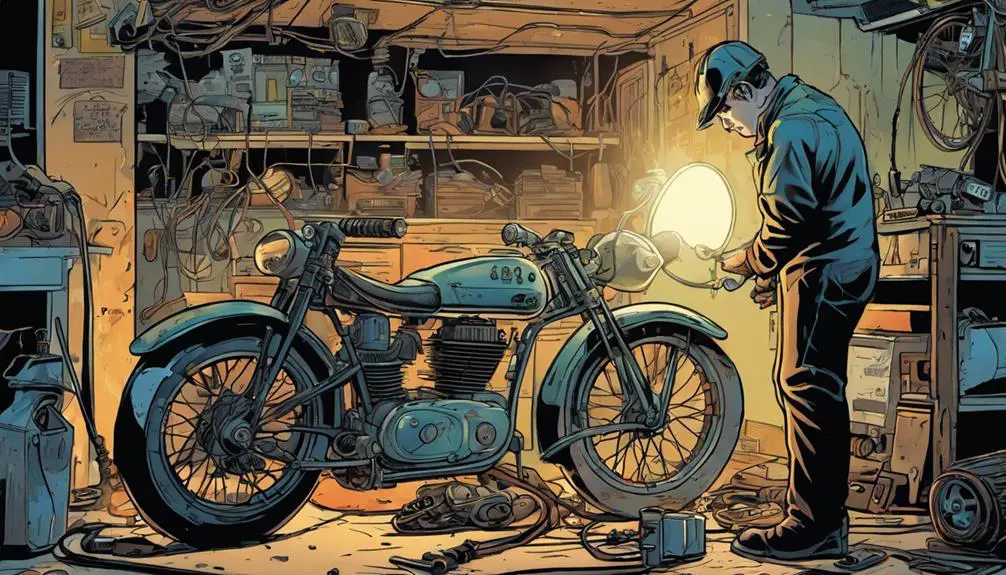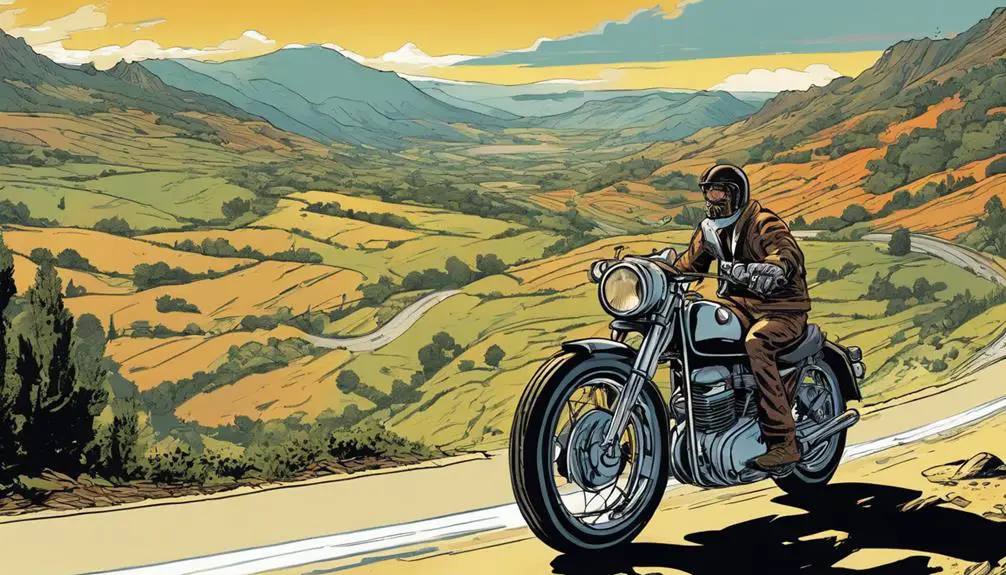When you think about early motorcycle models, it's easy to romanticize their simplicity and charm, but you might want to reflect on the common problems that plagued them. Electrical system failures often left riders stranded, while engine overheating could turn a joyride into a nightmare. Plus, inadequate suspension and handling issues compromised safety on the open road. These challenges not only affected performance but also shaped the evolution of motorcycle design. So, what can we learn from these early pitfalls that still resonate today?
Key Takeaways
- Early motorcycle models often suffer from electrical system failures due to corroded connections and outdated components, causing unreliable performance.
- Engine overheating is common, often caused by blockages, leaks, or faulty thermostats that restrict coolant flow and stress the engine.
- Suspension issues arise from outdated shock absorbers and poor-quality forks, leading to excessive bouncing and unstable handling during rides.
- Weak or dead batteries frequently disrupt electrical functionality, leading to starting problems and overall electrical system failures.
Electrical System Failures

Electrical system failures often plague early motorcycle models, leaving riders frustrated and stranded. You might find yourself enjoying the open road when suddenly, your bike's lights flicker or, worse, the engine dies. These electrical gremlins can stem from corroded connections, faulty wiring, or outdated components, threatening your freedom and adventure.
When this happens, it's crucial to take action. Start by checking the battery. A weak or dead battery can lead to all sorts of problems. Clean the terminals and verify they're securely connected. If the battery's fine, dig deeper into the wiring. Look for frayed or damaged wires, as these can disrupt your ride.
Investing in an updated electrical system can also liberate you from these frustrations. Modern components are more reliable and efficient, keeping you on the road longer.
Plus, understanding your bike's electrical layout helps you troubleshoot issues on the fly, guaranteeing you don't miss out on the thrill of the ride.
Don't let electrical failures hold you back; equip yourself with the knowledge and tools to keep your motorcycle running smoothly and confidently as you chase your freedom.
Engine Overheating Issues
As you tackle electrical system failures, be aware that engine overheating issues can also crop up in early motorcycle models, causing performance drops and potential damage. Understanding these problems can empower you to keep your ride free and fierce on the open road.
Here are some common causes of engine overheating you should watch for:
- Insufficient Cooling: Check if the cooling system is working properly, as any blockages or leaks can lead to overheating.
- Poor Oil Quality: Use the right oil and change it regularly; old or low-quality oil can't lubricate effectively, leading to heat buildup.
- Faulty Thermostat: A malfunctioning thermostat may prevent coolant from circulating, causing the engine to overheat.
- Radiator Issues: Inspect your radiator for dirt, debris, or damage that can hinder cooling efficiency.
Stay vigilant about these factors, and you'll not only preserve your machine's performance but also enjoy the freedom of the ride with peace of mind.
Suspension and Handling Problems

Many early motorcycle models face suspension and handling problems that can greatly affect your riding experience. You might notice excessive bouncing or a harsh ride, which can make your journey feel less like freedom and more like a chore. These issues often stem from outdated shock absorbers or poor-quality forks that struggle to absorb bumps in the road.
When you hit a pothole, you should feel connected to the road, not thrown off balance. If your bike sways or feels unstable in turns, it can rob you of that exhilarating sense of liberation you crave. Adjusting the suspension settings or upgrading to modern components can bring back that joy.
Don't ignore worn-out tires, either—having the right grip and responsiveness is essential for your safety and enjoyment. A mismatched tire size or insufficient tread can exacerbate handling woes, making you feel vulnerable instead of empowered.
Frequently Asked Questions
How Can I Improve Fuel Efficiency in Early Motorcycle Models?
To improve fuel efficiency in your early motorcycle model, start by keeping your tires properly inflated and checking for any leaks.
Regularly clean or replace the air filter to guarantee ideal airflow.
You might also consider using higher-quality fuel and keeping your bike well-tuned.
Reducing unnecessary weight and adopting smooth riding habits can make a big difference too.
Ride with purpose, and you'll feel the freedom of better mileage!
What Are the Best Maintenance Practices for Vintage Motorcycles?
When you think vintage motorcycles, you might picture endless repairs and frustration.
But with the right maintenance practices, you can enjoy the ride instead.
Start with regular oil changes, check your tires for wear, and keep the chain properly lubricated.
Don't forget to clean the air filter and inspect your brakes.
How Do I Identify Original Parts for Restoration?
To identify original parts for your restoration, start by researching your motorcycle's model and year.
Compare photos of original parts with what you have.
Check for manufacturer stamps, serial numbers, and any unique features that distinguish authentic components.
Joining online forums or vintage motorcycle clubs can provide valuable insights from fellow enthusiasts.
What Common Rust Issues Should I Look For?
When you inspect a motorcycle, the sight of rust can feel like a shadow creeping over its once-glorious frame.
Look closely at the metal parts, especially the chassis and exhaust. You'll want to check for flaking, pitting, or a reddish-brown hue that signals decay.
Pay attention to hidden areas, like behind brackets and under seat pans, where moisture can hide.
Catching these issues early can save you from costly repairs down the road.
Are There Specific Tires Recommended for Older Motorcycle Models?
When choosing tires for older motorcycle models, you'll want to focus on quality and compatibility.
Look for tires designed specifically for vintage bikes, ensuring they fit your model's specifications. Brands like Avon and Dunlop often offer suitable options.
Also, consider the riding conditions you'll face; different tread patterns can provide better grip on wet surfaces or enhance performance on dry roads.
Prioritizing safety and handling will enhance your liberating ride!
Conclusion
In the world of early motorcycles, it's clear that neglecting maintenance can lead to some serious headaches—like a smartphone that won't charge.
By addressing electrical failures, engine overheating, and suspension issues, you'll not only boost your bike's performance but also your safety on the road.
So, don't let these common problems keep you from enjoying the ride; stay proactive and keep your vintage machine in top shape for those unforgettable journeys ahead!